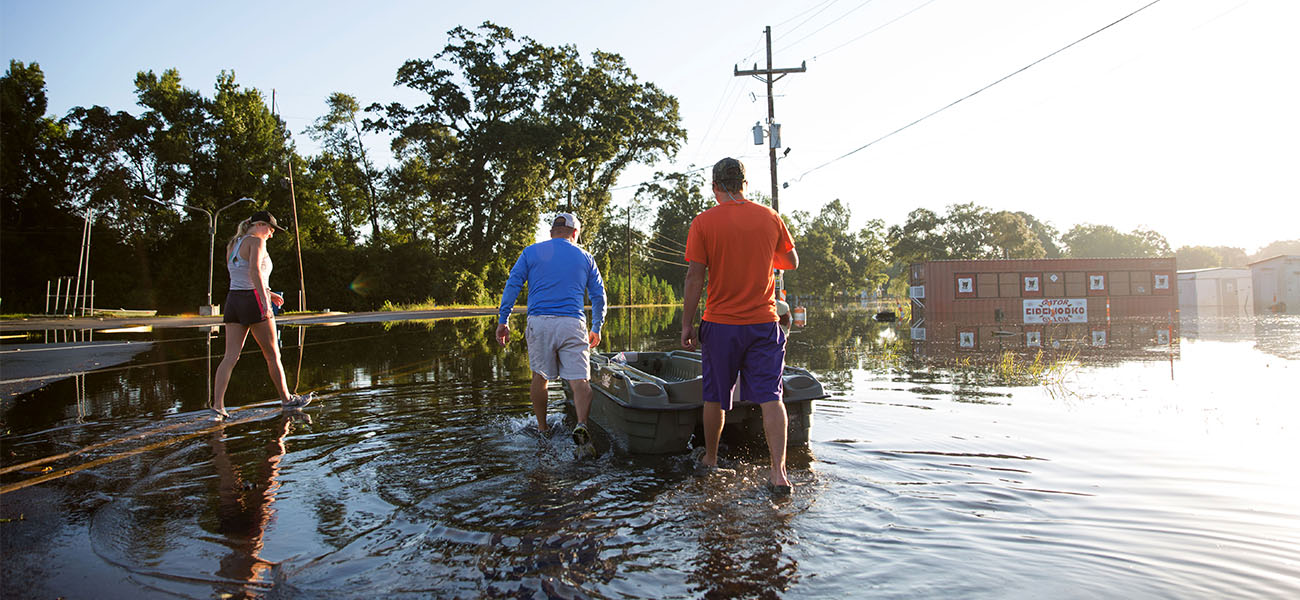
How Baton Rouge of the future could deal with climate change and flooding
Forward-thinking coastal communities aren’t trying to build up walls against rising water—they’re figuring out how to soak it in.
“You can’t just put stormwater in a pipe and get it out of the city as fast as possible,” says Camille Manning Broome, Center for Planning Excellence’s president and CEO. “Cities of the future will look quite different from the cities of today in that any new dollars will need to account for climate change. That means a lot of green infrastructure when it comes to thinking about stormwater drainage.”
What will that mean for us, in a region that’s on the frontlines of extreme weather events? Look to the parish’s parks for a preview.
|
|
During the catastrophic 2016 floods, some residents dodged a bullet when water diverted away from their neighborhoods and into low-lying conservation areas and parks. That porous greenspace was able to soak up and retain almost 10 billion gallons of water, according to Reed Richard, BREC’s assistant superintendent of planning and engineering.
“Our goal right now is to move forward in a more intentional way of designing our parks to increase the capacity to store floodwater with nature-based solutions,” Richard says. “And they are designed in such a way that when they aren’t flooded, they’re still a great recreational amenity.”
In much the same way apartment complexes or subdivisions build retention ponds to capture runoff from parking lots during a storm, new parks are being designed to do that, too. But they’d also employ other tricks we’re already seeing at some BREC facilities.
The modern visitor center at Magnolia Mound has a green roof that blends into the landscape and uses natural vegetation to capture and filter rainwater. New parking lots at Bluebonnet Swamp Nature Center are a mixture of gravel, turf and reinforced soil that can take a beating from cars while also pulling water into the ground rather than sending it off into ditches as a concrete lot would.
Amanda Takacs, BREC’s assistant director of natural resource management, says they are also looking at floating boardwalks that would rise and fall with floodwaters and building materials that can withstand a good soaking and don’t require much effort to rebuild or clean up. When it comes to landscaping, her team uses only native plant species better adapted to take in water or with deeper roots that hang onto soil and reduce erosion.
But are these lessons from the parks system transferable to commercial and residential construction in a city full of rapidly growing suburbs?
Richard looks to places like Amsterdam as an example of how to do it right. It’s below sea level and surrounded by water. But all of its infrastructure improvements have been streamlined. Rather than focusing on costly projects to keep water at bay, it uses greener solutions.
“Everyone is at the table. So you come up with more innovative ideas and maximize every bit of open space,” he says. “They look at the city as a sponge, and so there’s a multitude of things that they do that are just not that hard to imagine here. It’s just that they have the political will to do so.”
Takacs says BREC’s improvements, inspired by such sponge cities, could serve as a model for city planners.
“A lot of these changes are going to require some education, both for the public and policymakers,” Takacs says. “And if we have these spots where we can take people to get them used to seeing what some of this green infrastructure looks like, I think that’s a big help for the learning curve, too.” brec.org
211
Number of consecutive days the Mississippi River stayed above flood stage this year—a new record. According to a recent report from The Water Institute of the Gulf, that will only get worse. The report concluded that while high river levels are cyclical, the peaks are getting higher and greater in volume.
A swollen river can cause water seepage underneath the soaked levees, stalling construction projects and making it harder for barges carrying large loads to pass under bridges.
“If I was someone in industry planning long-term, I would plan for an increase in those high-stage events at least for the next decade,” Alex McCorquodale, a senior technical adviser at The Water Institute, told Business Report in September. thewaterinstitute.org
Migrating north?
Much the way New Orleans evacuees relocated here after Hurricane Katrina, Baton Rouge might end up providing a haven for coastal residents in the coming years due to rising sea levels.
Most research says Louisiana’s coast may lose another 2,000 to 4,000 square miles in the next 50 years. So how can the Capital Region prepare for an influx of new residents?
“We have to look at improving the housing stock we have here and marketing ourselves as a place where people migrating north can come,” says CPEX’s Camille Manning Broome. “That includes looking at the existing housing, transit infrastructure, and even the types of jobs that can adapt and support a population increase. There’s a huge opportunity for Baton Rouge to be a receiving community, and we need to prepare ourselves.”
CPEX will be hosting its annual Smart Growth Summit Nov. 12 at the Shaw Center downtown. summit.cpex.org
Command centers
Come hurricane season, the sports complex where your kids play basketball might be where FEMA and first responders establish base camp. BREC is developing its newest indoor sports facilities to double as “safe rooms” that can withstand strong winds and flooding.
One would be located at the improved Greenwood Community Park, another at Airline Highway Park, and the largest next to Memorial Stadium, which at 50,000 square feet would include several basketball courts and a two-level walking track.
“Ninety-nine percent of the time it would be a rec center,” says BREC Communications Director Cheryl Michelet. “But when disaster comes: We move out, they move in.”
This article was originally published in the November 2019 issue of 225 Magazine.
Click here to see more stories from our Imagining the Future cover story.
|
|
|

